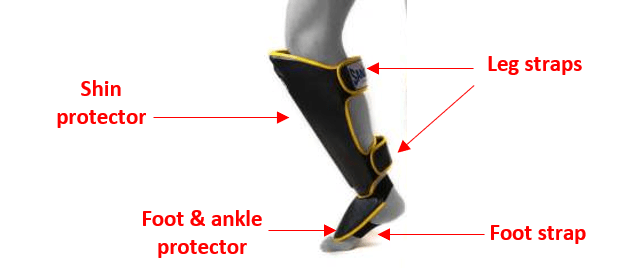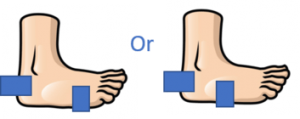
If you’re getting serious about your Muay Thai training, and looking to start sparring, it’s essential that you have a good pair of shin guards.
The shin bone is one of the most sensitive bones in the body, so it needs to be adequately protected at all times.
You also need to protect your sparring partners when landing big kicks to their body, limbs or head.
I have put this guide together to show you everything you need to consider when purchasing the best Muay Thai shin guards for your training – and show you some of my personal recommendations.
Brands and recommendations
Here are some of my favourite brands and recommended pairs shin guards
Generally the Thai brands tend to be best because they are hand made in Thailand and they have years of expertise in making Muay Thai gear – but some of the newer western brands have started to make some really good gear
RDX

RDX are a British brand who have been around since the 90’s producing gear for a wide range of martial arts.
The gear isn’t as high quality as the big Thai brands but their shin guards are certainly tough enough for the average trainer, and their prices are much more affordable.
RDX T1
The RDX T1 are the most basic shin guards on the market that can be used for Muay Thai. They are just about thick enough for sparring if you don’t mind the odd bruise here and there.
Pros
- Very cheap
- Snug fit with Velcro straps on the leg and two elastic straps on the bottom
- Light weight – don’t restrict movement too much
Cons
- Relatively thin which means some harder knocks will hurt you
- Plastic exterior which isn’t particularly durable
- Overall quality is nowhere near that of the Thai brand shin guards
RDX T4 **Best budget pick**
If you’re looking for a good protective pair of shin guards without breaking the bank, the RDX T4s are a great choice. They are a nice thick tough pair of guards which are certainly strong enough to protect you throughout lengthy sparring sessions.
Pros
- Budget friendly without compromising on quality too much
- Thick and sturdy with a leather exterior
- Good foot and ankle protection
- Thick sturdy leg straps hold the guards in place well
Cons
- Some people find the foot straps a little loose
- Although decent quality – they will still not last as long as the Thai brand guards
Venum

Venum are another western brand offering a range of MMA gear at a lower price than the big Thai brands.
Venum Challenger
The Venum Challengers are another low price alternative with a reasonable level of quality. Nice thick solid pads with a sound level of protection, but still not as tough, durable or flexible as the Thai made guards.
Venum Elite
The Elites are the closest thing a western brand has ever produced to a Thai brand quality pair of shin guards. The main reason is that they are handmade in Thailand and so come with all of the Thai hallmarks, strong materials and stitch work and a soft protective interior with hard exterior Sknitex leather shell. You do pay for the privilege of the quality, but these are certainly up there with the best guards I’ve tried.
Fairtex

Fairtex is one of the most popular Muay Thai brands in the world and you will see their gear in any gym you train in. They are a well established Thai brand, all their gear is handmade in Thailand and they are known for producing tough durable gear.
Fairtex SP7 **Best high end choice**
The Fairtex SP7 are an excellent choice if you have the cash to spend. They are high quality, made form tough syntex leather, and offer excellent protection and durability.
Pros
- Tough, durable and high quality leather providing strong protection
- Good width on shins and feet to protect sides of leg and ankles
- Chunky and sturdy Velcro leg straps to stop slippage
- Bottom strap across middle of foot makes them very comfy
- Foot cover rotates 90 degrees to give full flexibility for kicks
Cons
- Upper end of price range
Fairtex SP5
The Fairtex SP5s offer than same quality and thickness as the SP7s above, but the foot guards don’t have the same level of rotation and are slightly smaller. They are still are very good pair of guards and come at a slightly cheaper price.
Shin guards buying guide
Guide sections
- Shin guards – not shin pads
- Weight and thickness
- Foot and ankle protection
- Fastenings
- Material
- Size guidance
- How much to pay
- Brands and recommendations
Shin guards – not shin pads
When you spar in Muay Thai training, it’s crucial that you have the right level of protection on your shins.
Not only to protect your own shins, but also to prevent injury to your sparring partners.
When browsing online for shin protection, you will come across 2 types of shin protection products…
1) Shin pads

Shin pads are very lightweight, made of soft fabric, offer a thin protective layer of protection, and attach to the leg via an elasticated sleeve.
Do not use shin pads for your Muay Thai sparring.
They are too thin and don’t offer enough protection for the impact of Muay Thai kicks and blocks.
2) Shin guards
Proper Muay Thai shin guards like the examples above are thick, sturdy, have a leather exterior (or artificial leather) surrounding a foam body, and strap to the leg via Velcro or buckle straps.
Muay Thai shin guards are the only type of shin protection you should be using during sparring.
Components of a proper Muay Thai shin guard

Every Muay Thai shin guard should consist of…
- Shin protection – Longest part of the pad which should run from the top of the foot, to the bottom of the knee – ideally made of foam inside a leather shell.
- Foot/ankle protection – Foot and ankle cover (foam and leather) which protects from nasty niggling injuries to a vulnerable area
- Fitting straps – Straps which fasten your leg and foot to the guard. There should be two on the leg (calve and ankle level) and one or two on the foot.
Weight and thickness
Generally speaking you want a nice thick pair of shin guards for best protection.
But you also need to think about your freedom of movement during sparring.
A big bulky shin guard will provide lots of protection, but may restrict your agility and kicking speed.
Whereas a very slim light guard might allow you more freedom of movement, but not as much protection.
I would always advise going for chunkier, more protective pads.
It’s better to be more protected, even if it does reduce your mobility. In most cases, the difference in your performance won’t be huge and you will learn to kick better with the guards on as your training progresses.
These guards fall into the middle ground, offering plenty of protection and minimal restriction to movement.
Note: Whichever shin guards you opt for, they should be made of foam with a leather or artificial leather exterior – that is the only combination that will provide you with tough enough impact protection in Muay Thai sparring.
Foot and ankle protection
Foot and ankle protection is often overlooked in shin guard purchasing, but it’s actually very important.
Your foot and ankle have lots of small bones, and are fairly fragile in comparison to some of the knees and shins they will be coming into heavy contact with.
Wider foot protection is best in my opinion because it covers more of the foot and also round to the ankle.
In my opinion it’s crucial to pick a pair of shin guards which will protect your feet and ankles properly.
A nasty foot injury could put you out of training (and maybe even work) for some time.
You can also wear an ankle support sleeve for extra protection.
Fastenings
Muay Thai shin guards are fastened to the leg and foot as follows.
Leg straps
Two straps placed at the top and bottom of the shin component fasten the guard to the leg. Most good shin guards have Velcro fastening and nice thick straps to ensure the shin guards stay in place.
Avoid flimsy looking leg straps as they will cause the guards to slide around your leg when training. There is nothing worse than having to constantly stop your sparring sessions because you need to readjust your shin guards – it will irritate both you and your sparring partners.
Foot straps
Keeping your foot protection glued in place is also vital. Foot protection slipping out of place at the wrong moment can be very painful.
Foot straps will normally be made of elasticated fabric and come in 2 variations…
One strap

(Apologies for the rubbish illustration!)
One strip of elasticated fabric running across the middle of the foot.
Two straps

Two pieces of elasticated fabric.
Either, one running across the front of the foot, and one around the back of the ankle.
Or one running across the middle of the foot, and one on the ankle
My opinion on foot straps.
I find both of these methods hold the foot guard on well, but I prefer one strap for comfort and flexibility.
Or even a two strap with the bottom strap in the middle of the foot.
With two strap foot guards with a front strap on the toes, I find the front strap very irritating as you tend to spend a lot of time on your toes in sparring- and when kicking and I would prefer to have clean contact with the floor.
It’s a minor irritation, but certainly one I would rather not have when sparring – so I much prefer to go with a bottom foot strap which runs across the middle.
Material
Most good quality shin guards will be made of foam encased in a leather or synthetic leather covering.
Leather or synthetic leather is the only material you should have on the exterior of your shin guards – any fabric type materials will not be tough enough to absorb constant shin-to-shin contact.
Size guidance
Picking the right size when getting a pair of shin guards is vital.
Get a size too big and your shin guards will slide all over the place during sparring.
Get a size too small and you will not cover enough surface area on your shins or feet.
Picking the right size
Shin guards come in standard sizes such as small, medium large etc.
The size is relative to the length of your shin (yes, you will need to measure your shin!)
Unfortunately there is no universal sizing for shin guards, so the sizes vary from brand to brand.
My advice would be to always check the size chart of the brand you buy from – if you can’t find one on the site you are buying from, check the brand’s site directly.
As a general rule, the Thai brand pads tend to be smaller than the western brands – these two charts show how big the differences can be.

Once you receive your shin guards, they should fit in the following way:
The shin guard itself should start at the top of your ankle and run to the bottom of your knee.
If the guard finishes below the bottom of your knee, you will be leaving part of your shin exposed, which could result in injury to you or your sparring partner.
If the shin guard finishes above your knee, it will restrict your movements and disable your ability throw knees.
(The below video is a really good guide to fitting Muay Thai shin guards from Phoenix Combat Sports in Australia)
The foot guard should run from the top of your foot, and cover all of your foot apart from the toes.
If your foot guards stick out over your toes, it will restrict your ability to rise onto the balls of your feet, which will seriously impair your ability to throw kicks.
Note: If you order your shin guards online, try them on and make sure they fit properly before hitting the gym.
If they don’t fit well, send them back and get the right size. Don’t be tempted to rush off to the gym and hope you’ll be OK with a badly fitting pair – you will be better off waiting a few more days to get it right.
How much should you pay for shin guards?
How much you pay for your shin guards will depend on the quality, durability, material and fit.
You can expect to pay anywhere from £25 – £90 for shin guards.
Personally, I would recommend going towards the upper side of that range because quality is very important when it comes to shin guards.
Paying less will obviously save you money, but you will probably end up with a pair of shin guards that offer little protection and slide off your shins during sparring.
You can get away with going cheap when it comes to buying shorts or vests because they aren’t protective items, but much like your gloves; your shin guards need to be of a high standard to prevent injuries.
Which are the best Muay Thai shin guards for you?
As you’ve seen, there are lots of factors that make up the suitability of a pair of Muay Thai shin guards for you situation.
As mentioned, I think that quality is paramount when buying shin guards, because it’s an area that needs maximum protection in sparring, for both you and your sparring partners – and even when your looking to become a better pad holder, shin guards allow you to throw kicks and simulate a fight situation better
Essentially, you need a tough durable pair of shin guards that are thick and strong enough to absorb a constant barrage of kicks and blocks. They also need to fit well to ensure that they don’t slide around in training – and don’t forget to cover your feet and ankles properly.
Whenever you’re sparring don’t forget to wear a mouth guard at all times too – best to keep it in your gym bag at all times.
Happy training!
